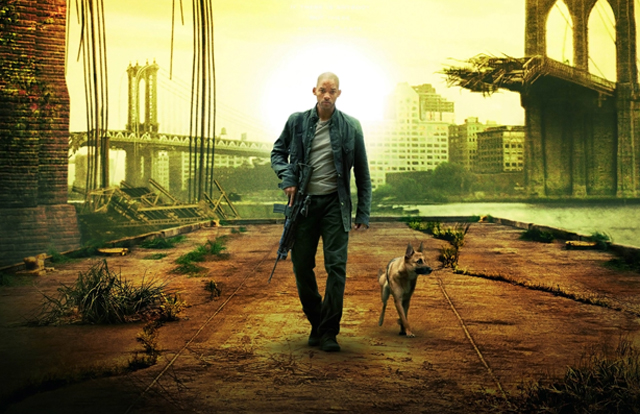
With the month of October arriving once again, audiences begin to crave the twisted thrills of horror on the big screen as it provides the right kind of atmosphere to match the tidings of this Halloween season. Hollywood has long provided generations worth of taut, scary thrillers of all kinds to satisfy their audiences, and it’s interesting to see how many different varieties have sprung up over the years. Universal Pictures popularized the monster flick with their rogues gallery of classic baddies. The 1950’s sci-fi craze began the era of the creature feature, which also saw the international contributions of Japanese cinema which popularized their giant Kaiju creatures like Godzilla (1954). Then of course the 70’s and the 80’s brought the rise of the slasher flick, which would go on to popularize new, very human monsters like Jason Voorhies, Freddy Kruger, and Michael Myers. But the current era of horror has yet to yield it’s own definable icons like ages past. More often than not, the nostalgia heavy culture we live in is more concerned with reinventing past movie monsters rather than creating new ones, like the upcoming Halloween reboot is about to. But if there is one cinematic creature that has really carved out an identity in the last couple years, it would be the zombie. For a while, zombie flicks became a red hot property in Hollywood, with both major studios and independent companies all taking their stab at it. Some would say it probably became over saturated for a while, as it seemed like it was all that Hollywood was producing at the time. But it’s all been in response to a genre that largely became devoid of anything original for a long time, and at least with the zombie flick, you didn’t have to rely on the same monster every time. Zombies became popular because of their lack of definition and because audiences recognized that the scariest possible thing in the world is that the monsters could be us.
The zombie flick may be popular now, but it’s roots extend further back. There were many films about the rising of dead dating back to Hollywood’s early years. There was the Bela Lugosi headlined thriller White Zombie (1932), though that was more about hypnotic control rather than the undead. Ed Wood had alien controlled zombies in his camp classic Plan 9 from Outer Space (1959). But, the genre wouldn’t see it’s true cinematic emergence until George A. Romero’s universally beloved Night of the Living Dead (1968). Romero’s film has since become the gold standard for all zombie movies since, defining among many things how the creatures would appear and act, what their weakness are, how they pose a danger to society, and most importantly, showing how survivors react when faced with the threat of a zombie attack. The legacy of that low budget, but extremely effective film are still felt today. But, despite how ground-breaking Living Dead was as a touchstone for the zombie sub-genre, the movie still owes a great deal to another inspiration; one that of course comes from literature. George Romero does point to the novel I am Legend as an inspiration for his film, and it’s clear to see what left an impression on him. Published in 1954 from writer Richard Matheson, I am Legend is largely seen as the originator of the modern zombie narrative, chronicling the aftermath of a pandemic that wipes out most human life on earth and showing a lonely survivor’s livelihood in a world now filled with the infected. It’s easy to see that the concept of the survivors’ story in a post apocalyptic world really resonated with the likes of Romero plus many others, and it’s effect no doubt touched Hollywood as well. Several adaptations have been made of I am Legend, including some wildly disparate versions like The Last Man on Earth (1964) and The Omega Man (1971). A far more earnest take on tackling the novel faithfully didn’t come until 2007 however, with the big budget version directed by Francis Lawrence (Hunger Games series) and starring Will Smith. But earnest doesn’t always mean faithful, and the 2007 film I am Legend shows how trying to bring a modern sensibility to a classic story doesn’t always result in a film that’s as effective as the written word.
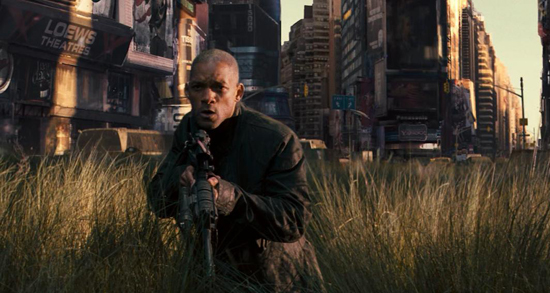
“My name is Robert Neville. I am a survivor living in New York City.”
For the most part, the movie does a fairly good job of following the basic premise of the story. Society has fallen due to a pandemic that caused the human population to turn into vampiric zombies. In the novel, Matheson does have rely on this hybrid concept of zombies that act like vampires, including retaining the same weaknesses like aversion to garlic and holy images, which in a way seems like a rather unnecessary addition to the story. Why would a disease suddenly make these once human creatures react so harshly to crucifixes and the like? Just wondering. But, the one vampiric trait that does help drive the story is that these zombies cannot survive in the daylight. The movie wisely uses this as the basic trait of the zombies, as they only pose a threat in the nighttime, which drives the feeling of isolation for the main character. Neville, or as he’s known Dr. Robert Neville in the film, is the only human left immune to the disease that transformed humanity, surviving by himself in the crumbling infrastructure of a once booming metropolis (Los Angeles in the book, New York in the movie). There, he scavenges for food, supplies, and other essentials before barricading himself up in his home while the zombie vampires swarm around his home at night. All the while, he researches to find the cause and possibly a cure for the disease in the hope of reversing it’s affects and bringing society back to where it was. The book and the movie stick very close together for the first half, and most of the movie’s earliest scenes do a really effective job of world building. The images of Manhattan Island crumbling after years of neglect and foliage now overtaking the once concrete jungle are strikingly realized. In this regard, I am Legend does the best job we’ve seen yet of capturing the landscape of the novel. Only once the plot starts to deviate that some of the problems in the adaptation begin to arise and the film itself starts to fall apart.
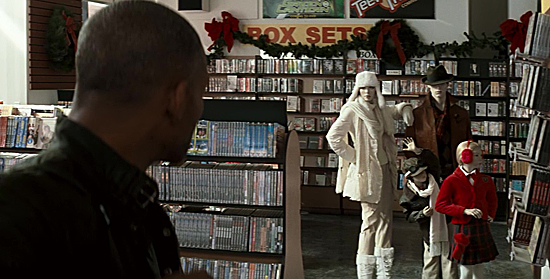
“This is ground zero. This is my site. I can fix this.”
It’s actually frustrating watching the movie version of I am Legend after reading the original novel, because there are many points that the movie does get right. For one thing, Will Smith’s performance is actually quite good in the movie. The actor forgoes his usually “slick Willy” swagger in favor of portraying a broken man who’s slowly losing his faith in a better tomorrow. I love how the movie also portrays the way he deals with his isolation. Throughout his daily routine, Neville goes out into the city and visits the same locations for his rations, including visiting a video store where he picks out something to watch back home. In every spot, he has set up department store mannequins, posed individually like they are going about their lives, and he interacts with them as if they were real people. One might look at this as a sign of insanity brought on by extended isolation, but it’s also a clever coping mechanism to allow for Neville to keep his remaining sanity in tact. The mannequins are an addition to the movie not found in the novel, and it works really well, helping to add another dimension to Neville’s character that is worthwhile. The film also expands on a subplot from the book involving Neville befriending a dog, who becomes his companion for a while. The film’s highlight is the heartbreaking point where the dog becomes infected and Neville has to put him down, which is effectively staged for the maximum amount of pathos. And these moments hint at a movie that not only could have been faithful to the source material, but also could have transcended it. Unfortunately, the film’s second, more conventional half reveals a different story, and one that sees a revisit from that old cinematic menace; studio interference.
The problem first begins when Neville is visited by other survivors who have the same immunity that he does. There is a similar episode in the books, where Neville finds another person walking the streets in the middle of the day just as he has been. This mysterious person, named Ruth, plays a wildly different role for the original story than the two new surviors in the movie, named Anna and Ethan (Alice Braga and Charlie Tahan) do in their roles. For the most part, Alice and Ethan serve merely as motivation for Neville to do what he was already on his way towards doing without the despair getting in the way, which is using his resources to find a cure. They are largely superfluous and are clearly there to give the movie a more conventional hero arc to Neville, basically meant to live to tell his story and make him a “legend.” But that’s not the message that the book had in mind. The big revelation about Ruth is (spoilers) that she is one of the infected as well, and has proven to Neville that those who have been infected have not lost all their humanity in the process. In fact, during the nighttime hours in which Neville has been sleeping in fear, the more sentient of the infected (mainly those who succumbed to it while they were still living) are still conscious of their being and have been trying to live their lives normally under the conditions, even seeking medication themselves. They have even domesticated some of the more feral (undead) zombies in the process, and have used them to hunt those who would hurt them, like Neville. It’s through this revelation that Neville becomes aware that as he has grown to fear and hate the zombie infected, they have reacted the same to him, and that he is even more of a monster from their perspective. It’s revealed that Neville was responsible for killing Ruth’s own husband, making Neville realize that his lack of view of their humanity has made him aware of just how much he has lost his own. In the novel’s closing chapter, Neville reflects on how he has become the monster that preys on these new creatures while they sleeping, saying, “I am a new superstition entering the unassailable fortress of forever. I am legend,” the passage which gives the story it’s name.
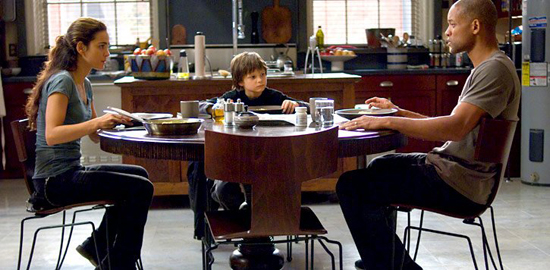
“The people, who were trying to make this world worse… are not taking a day off. How can I? Light up the darkness.”
Through this plot development, we see how Richard Matheson takes his story about vampire zombies and turns it into an allegorical story of mankind’s cruelty towards the natural world. It never dawned in Neville’s mind up until that point that he might be the villain; he was just doing what he could to survive another day. It’s that compromise of morals in desperate times that becomes the message of Matheson’s story, and it’s one that has likewise been very influential in zombie flicks and post-apocalyptic stories ever since. You see this in stuff like the Mad Max franchise and the Walking Dead TV-series, where the biggest threat isn’t the environment nor the undead zombies that have infested it. but rather the other desperate survivors among you who would just as readily kill you if it meant they would live another day. Desperation is the great leveler of civilization found in the story of I am Legend, and it’s a powerfully delivered message as well. So, it makes it doubly frustrating when the movie that is a direct adaptation of the book, completely disposes of that message. The truth is, when Hollywood invests so much into a big budget film, they are less willing to accept a more downbeat moral such as the one found in the book as the backbone of their story. Instead of being revealed as the layered character that he is the books, Neville falls into the mold of your typical savior figure who ends up saving the world. The movie even has him going out in a blaze of glory, blowing himself up with a grenade in the middle of a swarm of zombies, after conveniently discovering a cure minutes earlier and giving it to Anna and Ethan as they make their escape. There’s no allegory, no satisfying turnabout of Neville’s character. Everything is shaded in the black and white morality of humans beating back the scary monsters, which makes the story feel very unoriginal and contrary to the way it started.
And yet there is even a more problematic aspect to the way that the movie ended; it wasn’t always supposed to be that way. Director Francis Lawrence actually shot another ending for the film that was closer to the original. In this alternative ending, after Neville and the other survivors are cornered in his basement laboratory by a swarm of enraged (and poorly animated) zombies, Neville makes the shocking realization that the test subject that he retrieved days earlier was in fact the mate of the zombie’s alpha leader. In this moment, he realizes that he committed a kidnapping and that the zombies are only there to get back one of their own, and not to kill, unless provoked. Like his novel counterpart, movie Neville realizes he’s been a monster by not seeing the humanity that’s still in these creatures and he makes the conscious choice to let his last chance at a cure go in order to settle a peace with the creatures. This more complex ending, as it turns out, did not focus group well, and Warner Brothers decided to force a last minute re-shoot of the scene to create the more conventional ending. But, in doing so, it robs the remainder of the story of any real satisfaction. The ending from the book may not be ideal, but it is nevertheless though provoking. The ending of the movie is generic and forgettable. The movie may not have gained a bad reputation if this alternate ending was never seen, but for some reason Warner stuck it onto the home video release and marketed the alternate version as well, like they were proud of it. But if you were so proud of it, why didn’t you include it in the original movie. To me, it’s an extreme case of the studio not having the faith in the original story and not trusting their audience to be open to something more complex than the “save the day” narrative. Couple this with a lot of unnecessary scenes of explaining to the audience what led up to this (including a weird cameo from Emma Thompson in the prologue, playing the doctor who inadvertently caused the pandemic with her believed cure for cancer) and you’ve got a clear indication that the studio was not fully on board with all this, and tried to dumb the movie down. The thing that made I am Legend so memorable was that it made the reader feel unsafe and as a result terrified of what turn might come next. The movie leaves no surprises and scares absolutely no one.
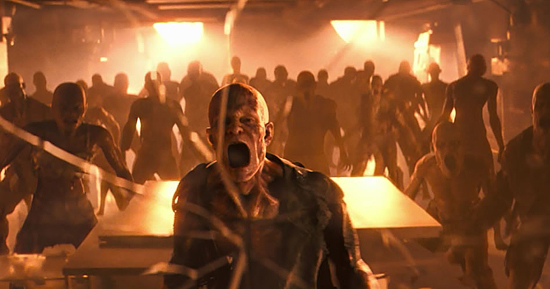
“God didn’t do this. We did.”
And that’s a shame too, because there are flashes of brilliance in the movie adaptation. Will Smith’s performance is effective up until that unnecessary ending, and I love the fact that his version of Neville is proactive in trying to retain some level of normality in this world. I get the feeling from that and the alternate ending that both him and the director wanted to come close to the message of the original story, but were undercut by the powers that be at Warners. In the end, the movie is a pale imitation of what could have been had the studio been more confident in the story. Richard Matheson knew that he was making a story not about monsters, but about people, and how sometimes evil acts are committed once we begin to lose that grasp of humanity that is ever so crucial in our society. There are so many cases where horrible, evil movements are created by demonizing another group as the “other” in modern society, and it’s even scarier when a person doesn’t even realize they are falling in that hole. Like many others, Neville believes that he is doing the right thing by fighting back against these zombies, but once he sees that these are beings who are struggling to survive just like him and that he’s been the menace in their lives, then the horrifying realization becomes apparent and he has to cope with the awareness of the evil that he has wrought. We are all susceptible to same downward spiral that Neville succumbs to, and that’s a frightening concept that has made this such a profound horrific story over time. Unfortunately, we have yet to see a movie capture Matheson’s story faithfully, though many films inspired by the novel have lived up to the spirit of it. Zombie movies can be quite scary when done right, but it becomes all the more unsettling once it shows the toll that it takes on those who manage to survive, and that even overcoming such a threat can awaken an even greater evil among the survivors.
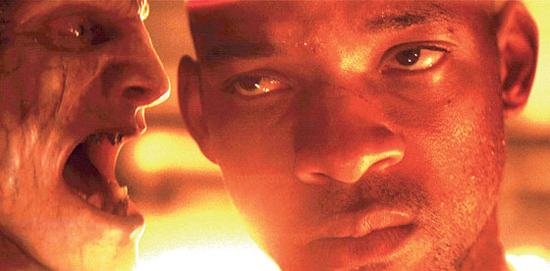
“Nothing happened the way it was supposed to happen.”